Famous Paintings of Jesus – A Look at the Art of Jesus Christ
Jesus must be one of the most iconic people in history. Thousands of Jesus paintings and Jesus drawings have been created through the ages, yet no one knows what he really looks like. Art of Jesus Christ has been made by amateur artists as well as the masters, leaving behind many Jesus on the cross paintings and other images of the divine being.
Table of Contents
- 1 Jesus and Art
- 2 Famous Paintings of Jesus
- 2.1 The Last Supper (1498) by Leonardo da Vinci
- 2.2 Salvator Mundi (1519) by Leonardo da Vinci
- 2.3 The Transfiguration (1520) by Raphael
- 2.4 The Last Judgment (1541) by Michelangelo
- 2.5 Christ Carrying the Cross (1580) by El Greco
- 2.6 Supper at Emmaus (1601) by Caravaggio
- 2.7 Christ Crucified (1632) by Diego Velazquez
- 2.8 The Yellow Christ (1889) by Paul Gauguin
- 2.9 Crucifixion (1933) by Francis Bacon
- 2.10 Christ of Saint John on the Cross (1951) by Salvador Dali
- 3 Frequently Asked Questions
Jesus and Art
The oldest painting of Jesus that we know about was painted around 235 AD and was discovered in Syria. It portrays Christ as a man in his youth, without any facial hair, and he is depicted in a manner that exudes dignity and authority. He has been portrayed with short hair and dressed in a pallium and tunic – the attire of a well-bred philosopher from the Greco-Roman era. In later versions, he is portrayed as slightly maturer and sporting a full beard.

Jesus was born in the middle-eastern region of Galilee and therefore would most likely have had darker skin, curly hair, and brown eyes. However, he is often portrayed as a European man with blue eyes and light hair.
Due to American and European Christians using their spiritual beliefs as an excuse to oppress people from other racial groups, it would not have served their cause to portray him as a person of color.
The Nazis from Germany were also responsible for trying to portray Christ as an Aryan, and not anything like his true Jewish looks. In 1940, an image of Christ painted by Warner Sallman also became extremely popular and was reprinted on many products and objects, further solidifying this incorrect image of a man from that region and time.
Famous Paintings of Jesus
Despite there being no certain clues as to what the real image of Jesus might have looked like, many painters have managed to capture his essence. Whether it is a portrait of Jesus, or one of the many Jesus on cross paintings, the context of the scene as well as his divine expression, have managed to convey a sense of who the painting is meant to represent.
Today we will take a look at the most famous paintings of Jesus throughout history.
The Last Supper (1498) by Leonardo da Vinci
| Medium | Fresco (Paint and Plaster) |
| Year of Painting’s Creation | 1498 |
| Dimensions of Artwork | 4.6 m x 8.8 m |
| Location Currently Housed | Santa Maria delle Grazie |
The Last Supper was painted in the 1490s as part of a contract for Ludovico Sforza, Duke of Milan, to restore the church and its structures. On the mural, Jesus tells his followers at the Last Supper that he would be betrayed by one of the people present. The original has been mostly damaged by environmental causes, despite several attempts at repair over the years.
As early as the early 1500s, the artwork had already begun to flake and deteriorate, reaching the point where it hardly resembled its previous splendor after just 50 years. Early repair efforts just made things worse.
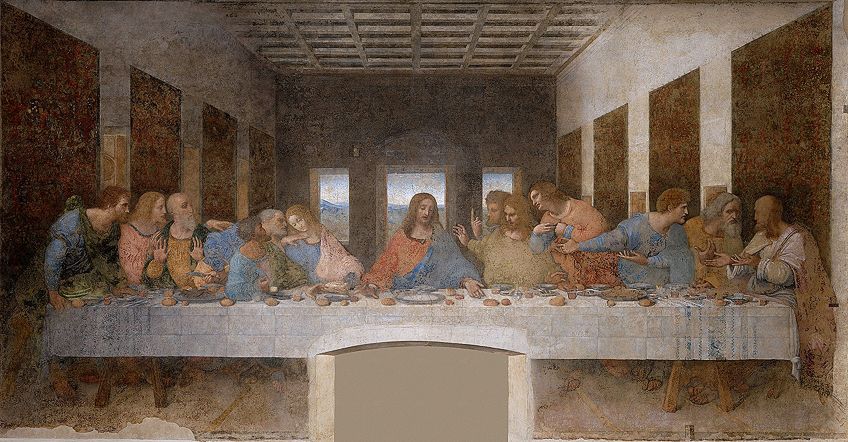
Allied bombings during World War II created severe vibrations that rocked the structure and severely damaged it. Much of the original paint had already been removed by the time the 19-year restoration project got underway in 1980. When a door was built in 1652 as part of repairs, a section of the painting on the bottom left, including Jesus’s feet, was damaged. Scholars think that each member of the group was modeled after a real person.
Leonardo da Vinci intended Judas to have the traits of a cynical and hardened criminal. It’s thought that he went through the Milan prisons looking for a suitable model for Judas.
Salvator Mundi (1519) by Leonardo da Vinci
| Medium | Oil on Walnut Panel |
| Year of Painting’s Creation | 1519 |
| Dimensions of Artwork | 45 x 65 cm |
| Location Currently Housed | Private Collection |
A multi-talented prodigy, Leonardo Da Vinci was an Italian painter who became famous for his innovations, inventions, and art. The majority of his renown was earned as a painter during the next four centuries and he is still considered as one of the finest artists in Western art history today. King Charles I of England was the first person to acquire this picture according to records. The Duke of Buckingham’s son sold it at auction in 1763, and Sir Francis Cook, an English art dealer, bought it in 1900.
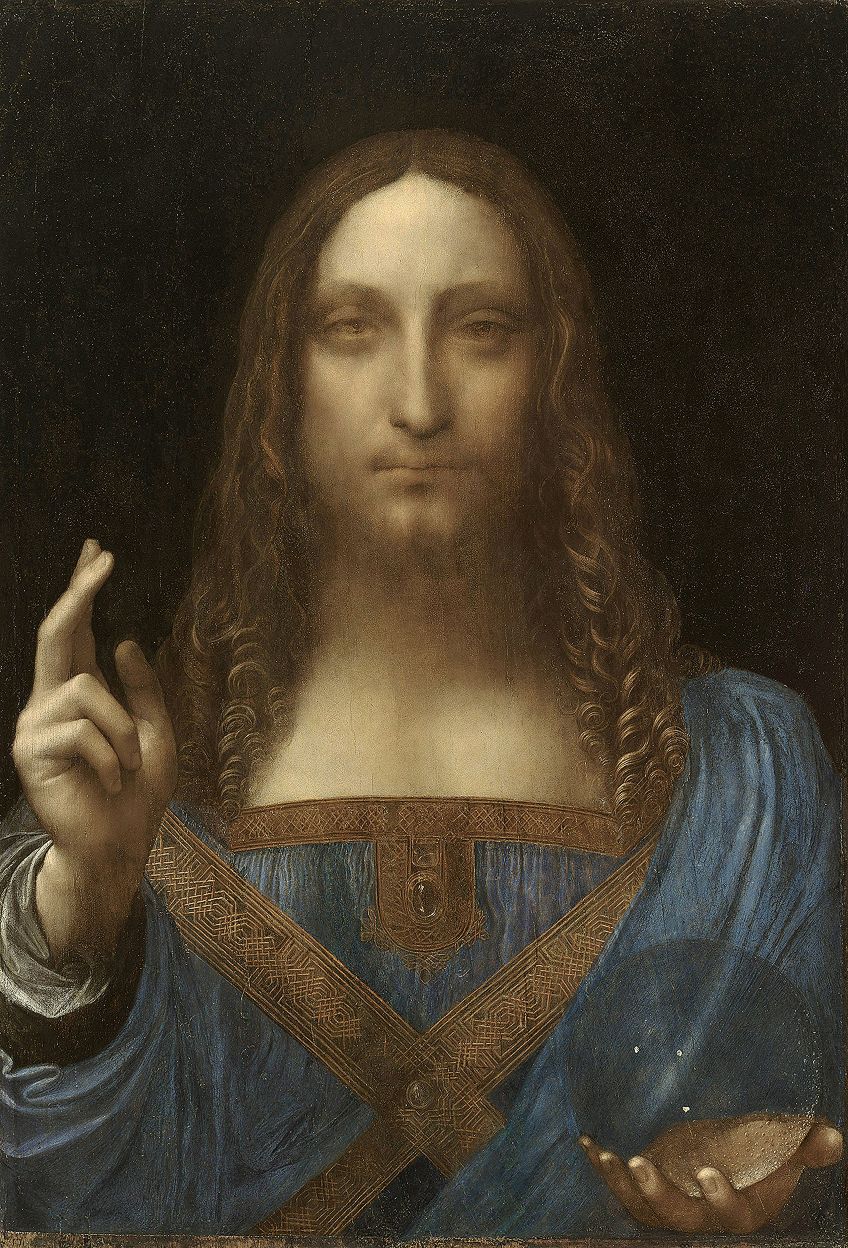
Sir Francis Cook’s family later sold it for £45 at another auction. For many years, it was considered to be a copy of a lost da Vinci painting by another artist, but after it was cleaned in 2006, numerous methods indicative of the master’s work were evident and it was reattributed to him. In spite of its notoriety as the world’s most costly artwork, many art historians still disagree whether it was painted by Leonardo da Vinci.
Christ is depicted as the world’s savior. It portrays him dressed in Renaissance garb, raising one hand in benediction while holding a crystal ball in his other.
The Transfiguration (1520) by Raphael
| Medium | Oil on Canvas |
| Year of Painting’s Creation | 1520 |
| Dimensions of Artwork | 410 x 279 cm |
| Location Currently Housed | Pinacoteca Vaticana, Vatican City |
There is little doubt that Raphael’s The Transfiguration is one of his finest works, as well as his last. It was commissioned by Cardinal Giulio de Medici of the banking family of the same name. Originally intended for the Narbonne Cathedral in France, where it would have served as the center entablature, it now resides in the Vatican’s Pinacoteca Vaticana. After Raphael’s death, the painting wasn’t sent to France. Instead of hanging on the cathedral’s altarpiece, it was given to the Blessed Amadeo Church in 1523.
During Napoleon’s 1797 campaign in Italy, it was taken by the soldiers from France and then exhibited in the Louvre Museum.

This artwork can be observed as portraying two images that oppose each other at the base level. On the one side, you have Christ with his power to redeem, the upper section of the composition is symbolic of the pure and symmetrical elements of the universe. On the lower section, the painting portrays Man and all of his shortcomings, represented by the scenes of chaos and gloom. This would be the last work he would ever create and continued to work on until the last days of his life.
After the stunning art of Jesus Christ was cleaned in the mid-1970s, it was revealed that he had done most of the work himself, with only a few of the beings in the bottom half being completed by his assistant painters.
The Last Judgment (1541) by Michelangelo
| Medium | Fresco (Paint and Plaster) |
| Year of Painting’s Creation | 1541 |
| Dimensions of Artwork | 14 m x 12 m |
| Location Currently Housed | Sistine Chapel |
This massive masterpiece was created by Michelangelo and it takes up the complete wall of the Chapel’s altar. Due to the number of people that he included in the composition, as well as the sheer size and impracticalities, it took him around four years to finish the mammoth task. He began his work on the fresco about a quarter of a century after the chapel was first constructed, and when the piece was complete, he was already 67 years old.
Although the entirety of the men in the painting was portrayed as being naked, they were later covered with draperies that were painted over the offending regions.

Critics gave the piece a mixed reception, with some people criticizing the level of nudity and muscularity of the figures, while others heaped praise upon it. The fresco represents the day when Christ returns to earth to hand out Mankind’s final judgment. Around 300 deceased beings can be observed rising up towards the heavens, as Christ and his saints judge the souls for worthiness. It was finished under the reign of Pope Paul III, despite being ordered to be painted by the previous Pope, Clement VII.
The conservative views of the later Pope would have been greatly influential in the decision to have the painting modified to be more modest in its depiction of the human form.
Christ Carrying the Cross (1580) by El Greco
| Medium | Oil on Canvas |
| Year of Painting’s Creation | 1580 |
| Dimensions of Artwork | 105 cm x 79 cm |
| Location Currently Housed | Metropolitan Museum of Art, New York |
El Greco created many Jesus on the cross paintings throughout his illustrious career in Spain. This one, however, differs in the fact that there is no discernable context or background, and the image of Christ is the only one in the composition. Jesus is depicted carrying the full weight of the cross on the way to his own crucifixion. It captures a moment of deep reflection as Christ intends to die to save humanity from its sins, the ultimate self-sacrifice.
El Greco’s paintings were genuinely unique since he blended the artistic elements of three separate eras and ideals of art.

Overall, they captivated a fresh spirit regarding the body’s design. Greco’s figures were frequently long, stretched shapes that were practically flowing in character. His paintings were typically Romantic in nature and focused on how Man suffered and loved through hurt and contention. El Greco was also influenced by Renaissance techniques and ideals, specifically the notion that the ideal human form was a purified link to divinity. The majority of Greco’s works depicted figures associated with this divine and iconoclastic state of being.
El Greco’s figures, on the other hand, were frequently distorted and elongated, in contrast to the pure proportion and flawlessness of the Renaissance natural body shape.
Supper at Emmaus (1601) by Caravaggio
| Medium | Oil on Canvas |
| Year of Painting’s Creation | 1601 |
| Dimensions of Artwork | 141 cm x 196 cm |
| Location Currently Housed | The National Gallery |
Caravaggio was an Italian painter whose works combined a precise study of the human condition, both emotional and physical, with lighting that was very dramatic. He is considered among the most important painters in Western art, and his paintings shaped the Baroque style of painting. Supper at Emmaus, one of Caravaggio’s most renowned religious paintings, represents the moment when the risen Christ first showed himself to two of his followers, most likely Cleopas and Luke, in the village of Emmaus.
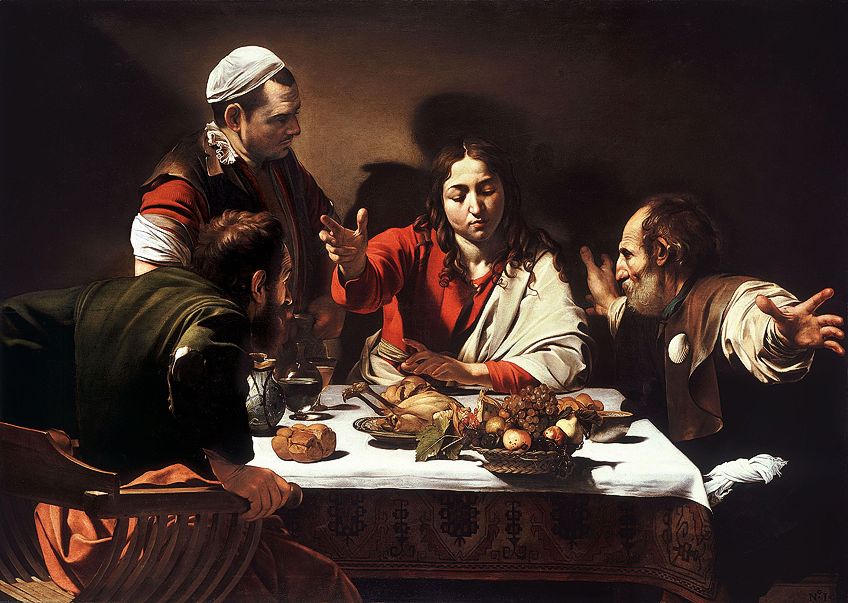
In actuality, the Jesus painting portrays the exact moment the two apostles realize they are witnessing a supernatural event. Christ is seen beardless, and his billowing garments conceal any evidence of the wounds he received through the Crucifixion. The groom, whose brow is sleek and his face is darkened, is standing there seemingly clueless about what’s going on.
The picture is unique in that it features life-sized people against a black, empty backdrop. A still-life dinner is set up on the table. The food basket teeters precariously on the brink, just as the world these disciples knew.
The unexalted nature is appropriate for this scenario since the human Jesus has rendered himself unrecognizable to his disciples and simultaneously affirms and transcends his humanity.
Christ Crucified (1632) by Diego Velazquez
| Medium | Oil on Canvas |
| Year of Painting’s Creation | 1632 |
| Dimensions of Artwork | 249 cm x 170 cm |
| Location Currently Housed | Museo del Prado, Madrid |
Spain’s Golden Age artist and painter Diego Velazquez was active in the 17th century and often regarded as its most important figure. He is renowned for his portraits and served as King Philip IV’s royal painter. This picture of Jesus on the cross, done by Velazquez in the middle of his career, shows him moments following his death. Apart from the cross, the artwork is remarkable for its absence of story elements.
A work of remarkable uniqueness and mastery in its combination of calm, grandeur, and majesty, this painting is regarded as a watershed moment in Velazquez’s creative growth.
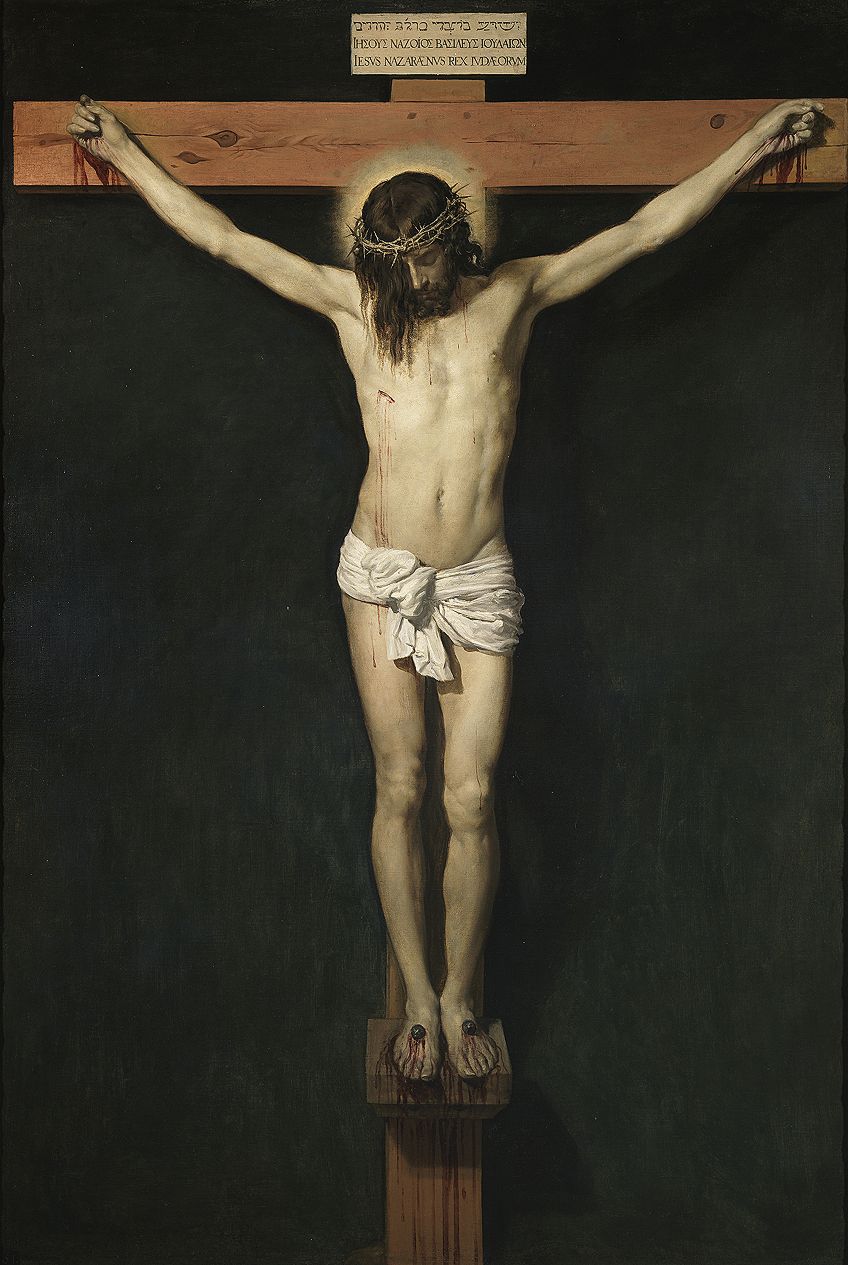
It is the artist’s most famous religious picture and has influenced much poetry. The date of the artwork is unclear given the lack of documentation. Nonetheless, scholars think the painting was completed after Velázquez’s return from Italy, most likely between 1631 and 1632. The tranquil stance of the torso, the stylized visage, and the reclining head all reveal the influence of Classicist painting.
The influence of Caravaggism, on the other hand, can be observed in the intense chiaroscuro between the backdrop and the torso, as well as the bright, artificial lighting above the cross.
The Yellow Christ (1889) by Paul Gauguin
| Medium | Oil on Canvas |
| Year of Painting’s Creation | 1889 |
| Dimensions of Artwork | 91 cm x 73 cm |
| Location Currently Housed | Albright-Knox Art Gallery |
Paul Gauguin was a French painter who was active largely throughout the nineteenth century and is today regarded as one of the most prominent painters of the art style Post-Impressionism, which expanded Impressionism while rejecting its constraints. This painting, as with another by Gauguin named The Green Christ, is considered one of the first and most essential pieces of Symbolism in art.
This painting depicts Christ’s crucifixion in 19th-century northern France, while women gather in prayer.

The composition is rich in symbolism, such as the person jogging in the background, which represents the yearning of the 19th century for people to escape city life and return to a more “primitive” and basic way of life. Gauguin’s “synthetism” approach, as shown by the Yellow Christ, goes beyond symbolism. Vivid colors and thick encircling outlines were used to make this, along with flat planes.
Crucifixion (1933) by Francis Bacon
| Medium | Oil on Canvas |
| Year of Painting’s Creation | 1933 |
| Dimensions of Artwork | 62 cm x 48 cm |
| Location Currently Housed | Private Collection |
A far more contentious depiction of Jesus and the crucifixion, Francis Bacon painted this picture while he was just around 24 years of age. Bacon, one of the few contemporary painters on the list, spent a lot of time working on religious works. It was his first piece to garner widespread attention, and the proceeds from subsequent sales enabled him to afford his first solo show, which unfortunately received a poor review in the Times.
As a result, Bacon destroyed several of his previous paintings, including crucifixion pictures. He would subsequently claim that the other crucifixion paintings were among the few that he regretted erasing.
Like many abstract paintings, this sort of work for the general public might be difficult to understand, but it is only when viewed in the context of Bacon’s previous work that its genius becomes apparent. An abstracted white human figure with arms outstretched against a dark background is shown in this gloomy painting in black, white, and grey tones. Lines signifying walls meeting a floor, as well as the horizontal bar of the cross, define space. Jesus on the crucifixion is represented as a stick figure, with thin white arms looping around the cross, skinny legs, and the head, hands, and feet diminished to pale lumps.
Christ of Saint John on the Cross (1951) by Salvador Dali
| Medium | Oil on Canvas |
| Year of Painting’s Creation | 1951 |
| Dimensions of Artwork | 205 cm x 116 cm |
| Location Currently Housed | Kelvingrove Art Gallery |
Surrealism’s most important artist, Salvador Dali, is internationally recognized. The artwork is referred to as Christ of Saint John of the Cross because of its design, which was influenced by a sketch by the 16th-century Spanish Franciscan John of the Cross. The arms of Christ and the horizontal of the cross make a triangle, while Christ’s head forms a circle in the composition. It is possible to interpret the triangle as a nod to the Holy Trinity, but the circle may stand for unity, which means that everything is interconnected. Despite the fact that it depicts the crucifixion, the artwork is free of nails and blood.
After a cosmic dream in which he was concerned that depicting nails and blood would detract from Christ’s image, Dali decided to paint this picture.
Scotland’s favorite picture, Christ of Saint John of the Cross was selected in a 2006 survey. It’s one of the most well-known pieces by a major contemporary artist, and it’s often regarded as the best religious painting of the twentieth century. Dal had Hollywood stuntman Russell Saunders hung from an above scaffolding to observe how the body would look from the required perspective and to imagine the force of gravity on the human body in order to construct the image of Christ. The body of water portrayed is the bay of Port Lligat, Dal’s house at the time of the painting.
Today we have learned about some of the most famous paintings of Jesus. The portrait of Jesus is an age-old image that has changed over time. Jesus art is as varied as there are styles of painting, with Jesus drawings found in every movement and style. The art of Jesus Christ continues to inspire and fascinate religious people. From Jesus paintings that depict Christ among his disciples to Jesus on the cross paintings that depict him alone and dying, we hope you have enjoyed our top list of famous paintings of Jesus.
Take a look at our Jesus art webstory here!
Frequently Asked Questions
Why Was Jesus Depicted as a White European Man?
Because Jesus was born in Galilee, a location in the Middle East, he most likely had a darker complexion, curly hair, and brown eyes. However, he is frequently shown as a white male with blonde hair and blue eyes. Because Christians in the United States and Europe use their religious beliefs as a justification for oppressing people of color, portraying him as a black man would have fit their purposes. It was the German Nazis that portrayed Christ as an Aryan and not at all like his genuine Jewish appearance. Another iconic image of Christ, painted by Warner Sallman in 1940, was replicated on a variety of items and objects, further reinforcing the erroneous perception of a man from that place and period.
Are Paintings of Jesus Expensive?
The most expensive painting ever sold was a portrait of Jesus painted by Leonardo da Vinci. The painting is called Salvator Mundi and sold for $475 million.
How Old Is the Oldest Painting Of Jesus?
The oldest painting of Jesus around was painted in 235 AD. It was discovered in Syria and portrays Christ as a young beardless man.
Isabella studied at the University of Cape Town in South Africa and graduated with a Bachelor of Arts majoring in English Literature & Language and Psychology. Throughout her undergraduate years, she took Art History as an additional subject and absolutely loved it. Building on from her art history knowledge that began in high school, art has always been a particular area of fascination for her. From learning about artworks previously unknown to her, or sharpening her existing understanding of specific works, the ability to continue learning within this interesting sphere excites her greatly.
Her focal points of interest in art history encompass profiling specific artists and art movements, as it is these areas where she is able to really dig deep into the rich narrative of the art world. Additionally, she particularly enjoys exploring the different artistic styles of the 20th century, as well as the important impact that female artists have had on the development of art history.
Learn more about Isabella Meyer and the Art in Context Team.
Cite this Article
Isabella, Meyer, “Famous Paintings of Jesus – A Look at the Art of Jesus Christ.” Art in Context. September 23, 2021. URL: https://artincontext.org/famous-paintings-of-jesus/
Meyer, I. (2021, 23 September). Famous Paintings of Jesus – A Look at the Art of Jesus Christ. Art in Context. https://artincontext.org/famous-paintings-of-jesus/
Meyer, Isabella. “Famous Paintings of Jesus – A Look at the Art of Jesus Christ.” Art in Context, September 23, 2021. https://artincontext.org/famous-paintings-of-jesus/.


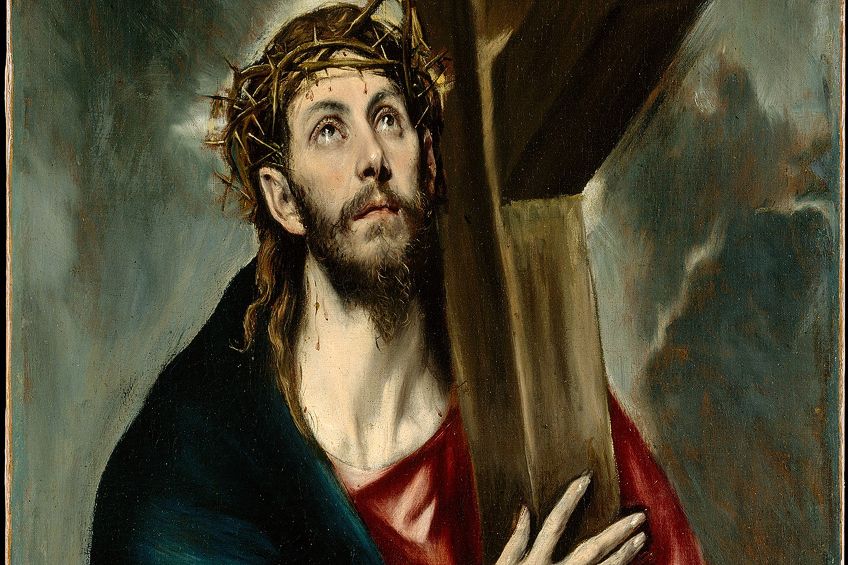

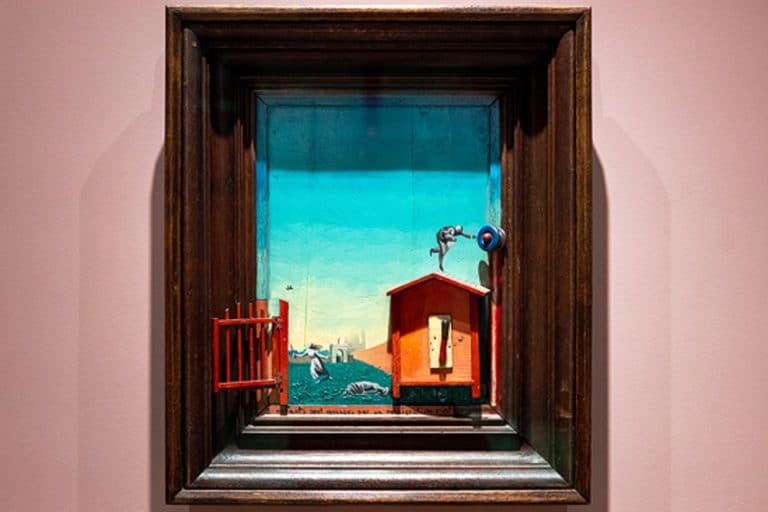
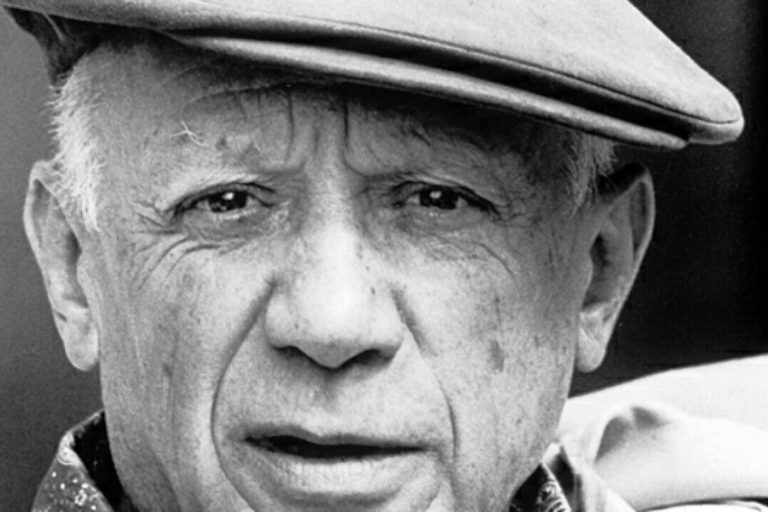
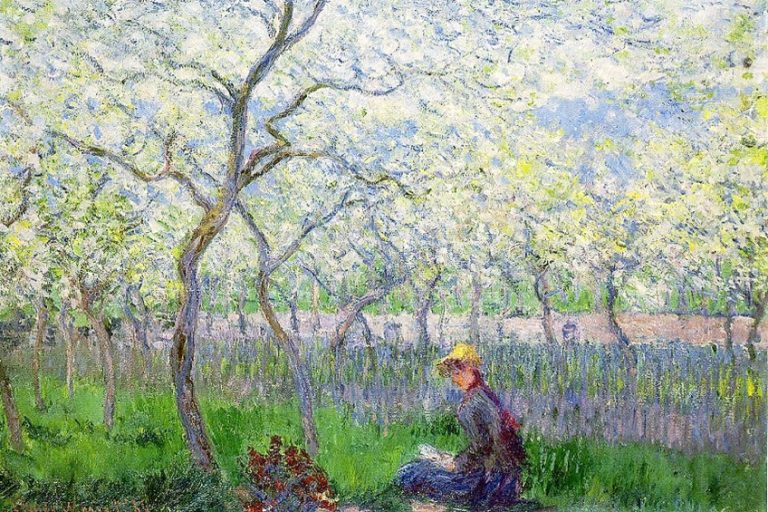

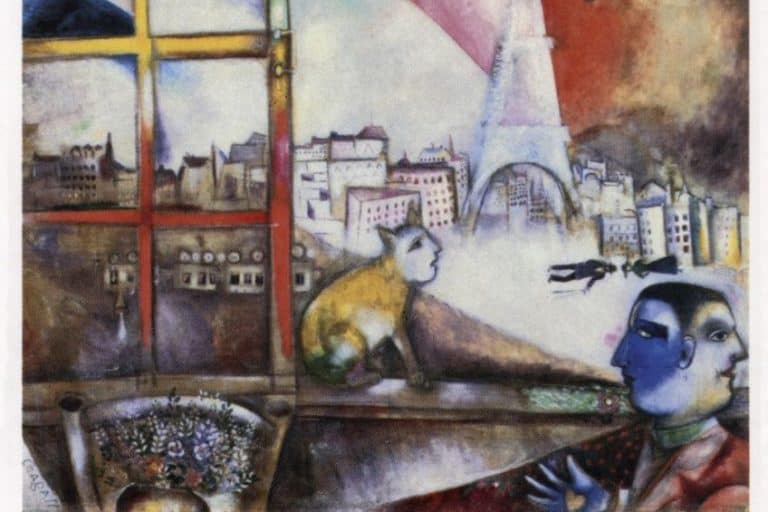



I have a different personal opinion: The first established Christian church was in Ethiopia. Christianity was in Africa before it ever came to Europe. On top of that, Quakers, along with Baptists, Mennonites, and many more Christians were the FIRST to abolish slavery in the United States. The abolition movement wouldn’t have existed if not for Christians who felt compelled to disband the franchise. Secular liberals and deists such as Thomas Jefferson were quite happy with the franchise. It was the “wacky Christians” who pushed the abolitionist movement.